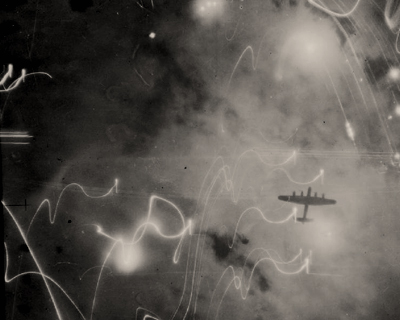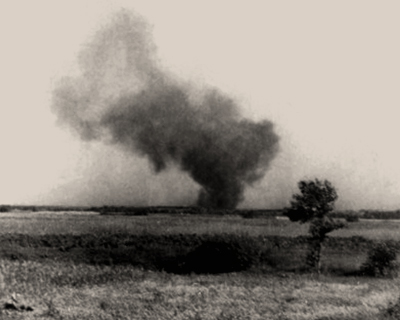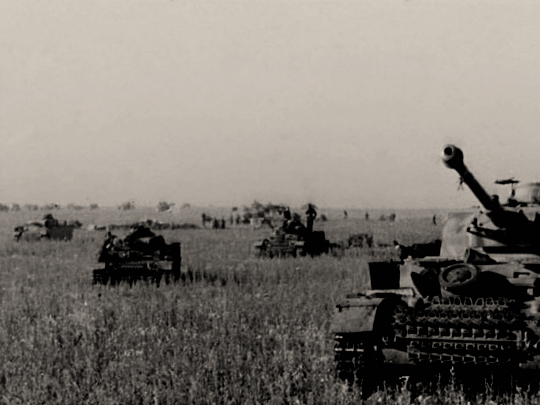German Federal Archives / Wikimedia Commons / CC-BY-SA-3.0 / GFDL
1 – Battle of Kursk – Russians Win the Largest Tank Battle in History
The Battle of Kursk was a World War 2 engagement, between German and Soviet forces on the Eastern Front near Kursk, in the Soviet Union, during July and August 1943.
The German offensive was code-named Operation Citadel and it proved to be the largest tank battle in history.
The battle was the final strategic offensive the Germans were able to launch on the Eastern Front.
The Germans hoped to weaken the Soviet offensive potential for the summer of 1943 by cutting off a large number of forces that they anticipated would be in the Kursk salient.
It was also hoped that large numbers of Soviet prisoners would be captured to be used as slave labor in the German armaments industry.
The greatest tank battle of the war, at Prokhorovka, took place about 50 miles to the south-east of Kursk, on July 12. In total, 1,500 tanks were involved.
The Germans could not break through, however, losing 350 tanks and 10,000 men. The Germans’ strength in the south of the Kursk salient had been broken and the Russians launched a major counter-offensive.
By July 23rd, the Germans had been pushed back to where they had started their attack.
The Battle of Kursk was the first time in the War that a German offensive was halted before it could break through enemy defenses.
Though the Red Army had succeeded in winter offensives, their counter-offensives following the German attack at Kursk were their first successful strategic summer offensives of the war.
The extensive loss of German men and tanks ensured that the Red Army enjoyed the strategic initiative for the remainder of the war.
2 – Japanese Troops Evacuate Guadalcanal, Ends Epic WWII Battle on the Solomon Islands in the Pacific

Operation Ke was the largely successful withdrawal of Japanese forces from Guadalcanal at the conclusion of the Guadalcanal Campaign during World War 2.
The operation took place between 14 January and 7 February 1943 and involved both army and navy forces under the direction of the Japanese Imperial General Headquarters.
The Japanese decided to withdraw and concede Guadalcanal to Allied forces for several reasons.
All attempts by the Japanese army to recapture Henderson Field, the airfield on Guadalcanal in use by Allied aircraft, had been repulsed with heavy losses.
Japanese ground forces were beginning to die in large numbers from starvation and the lack of adequate medical care.
Japanese naval forces in the area were also suffering heavy losses attempting to reinforce and supply their forces on the island. The decision to withdraw was endorsed by Emperor Hirohito on 31 December 1942.
The operation began on 14 January with the delivery of a battalion of infantry troops to Guadalcanal to act as rearguard for the evacuation.
In total, the Japanese evacuated 10,652 men from Guadalcanal at a cost of one sunken destroyer, with three others damaged.
On 9 February, Allied forces confirmed that the Japanese were gone and declared Guadalcanal secure, ending the six-month campaign for control of the island.
3 – The British Bomb Hamburg Causing a Firestorm that Kills 42,000 German Civilians

The Allied bombing of Hamburg during World War II included numerous strategic bombing missions and diversion/nuisance raids.
As a large port and industrial center, Hamburg’s shipyards, U-boat pens, and the Hamburg-Harburg area oil refineries were attacked throughout the war.
The attack, codenamed Operation Gomorrah, began 24 July 1943 and lasted for 8 days and 7 nights. It was carried out by the Royal Air Force and United States Army Air Forces.
It created one of the largest firestorms in World War II, killing 42,600 civilians and wounding 37,000 in Hamburg, virtually destroying most of the city.
The warm weather and conditions meant that the bombing was highly concentrated around the intended targets.
It created a vortex and whirling updraft of super-heated air which created a 1,500-foot-high tornado of fire, a totally unexpected effect.
An early form of chaff was successfully used for the first time by the RAF, clouds of tinfoil strips dropped by Pathfinders, as well as the initial bomber stream, in order to completely cloud German radar.
The raids inflicted severe damage to German armaments production in Hamburg.
4 – Armed Revolt Breaks Out in Treblinka – Crematorium Destroyed

Treblinka was an extermination camp built by Nazi Germany in occupied Poland during World War 2, located in a forest north-east of Warsaw.
The camp operated between 23 July 1942 and 19 October 1943.
Between 700,000 and 900,000 Jews were killed in its gas chambers, along with 2,000 Romani people. More Jews were killed at Treblinka than at any other Nazi extermination camp apart from Auschwitz.
Managed by the German SS and the Eastern European Trawnikis, the camp consisted of two separate units.
Treblinka I was a forced-labor camp (Arbeitslager) whose prisoners worked in the gravel pit or irrigation area and in the forest, where they cut wood to fuel the crematoria. The second camp, Treblinka II, was an extermination camp (Vernichtungslager).
Between 1941 and 1944, more than half of its 20,000 inmates died from executions, hunger, disease, and mistreatment.
A small number of men who were not killed immediately upon arrival became its Jewish slave-labor units called Sonderkommandos, forced to bury the victims’ bodies in mass graves.
These bodies were exhumed in 1943 and cremated on large open-air pyres along with the bodies of new victims.
Gassing operations at Treblinka II ended in October 1943 following a revolt by the Sonderkommandos in early August.
Several SS Trawniki guards were killed and 200 prisoners escaped from the camp, with almost a hundred surviving. The camp was dismantled ahead of the Soviet advance.
A farmhouse for a watchman was built on the site and the ground ploughed over in an attempt to hide the evidence of genocide.
5 – The White Rose Student Group Caught & Beheaded in Munich
The White Rose was a non-violent, intellectual resistance group in Nazi Germany led by a group of students and a professor at the University of Munich.
Founded by Hans Scholl, his sister Sophie, Christoph Probst, Willi Graf, and Alexander Schmorell, they were one of the few German groups that spoke out against Nazi genocidal policies.
They conducted anonymous leaflet and graffiti campaigns in the greater Munich region.
Their activities started in Munich in June 1942 and ended with the arrest of the core group by the Gestapo in February 1943. They faced unjust trials by the Nazi People’s Court and many were sentenced to death or imprisonment.
Hans & Sophie Scholl were arrested, tried, found guilty and executed by guillotine, along with their friend Christoph Probst, on 22 February 1943.
Alexander Schmorell attempted to flee to Switzerland but was forced to turn back by heavy snow. After returning to Munich, he was captured entering an air raid shelter during a bombing raid. He was later executed.
Later campaigns saw secret carriers bring leaflets to other cities, mostly in southern Germany.
In total, the White Rose authored six leaflets, which were multiplied and spread, in a total of about 15,000 copies.
They spoke out about the Nazi regime’s crimes and oppression and called for resistance. In their second leaflet, they openly denounced the persecution and mass murder of the Jews.
6 – The Bengal Famine

The Bengal famine of 1943 struck the Bengal Province of British India (present-day West Bengal, Odisha, Bihar and the country of Bangladesh) during World War II following the Japanese occupation of Burma.
Approximately 3 million people died due to famine.
Generally, the estimates are between 1.5 and 4 million, taking into account death due to starvation, malnutrition, and disease, out of Bengal’s 60.3 million population.
Half of the victims died from diseases after food became available in December 1943.
Although food production was higher in 1943 compared to 1941, due to the British empire taking 60% of all harvests and ordering Bengal to supply food for their army to fight the Japanese, the demand exceeded the supply.
As in previous Bengal famines, the highest mortality was not in previously very poor groups, but among artisans and small traders whose income vanished when people spent the money they had on food.
The famine also caused major economic and social disruption, ruining millions of families.
